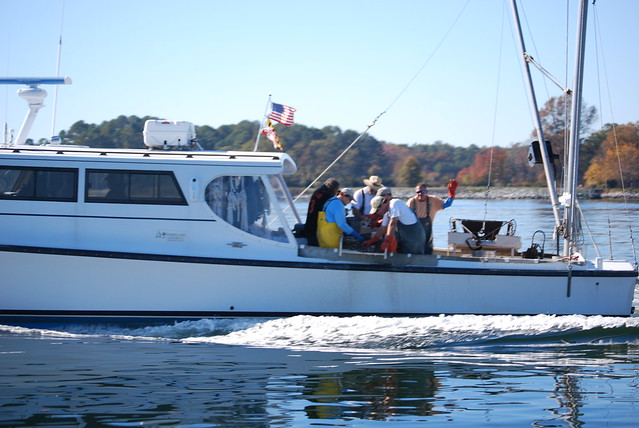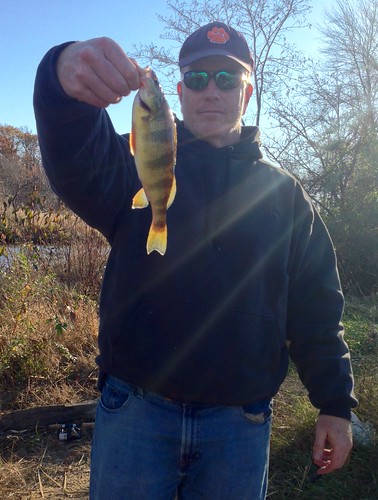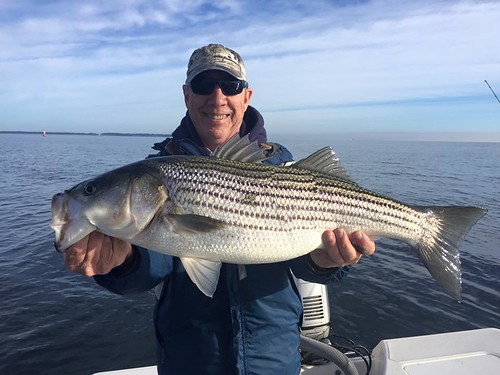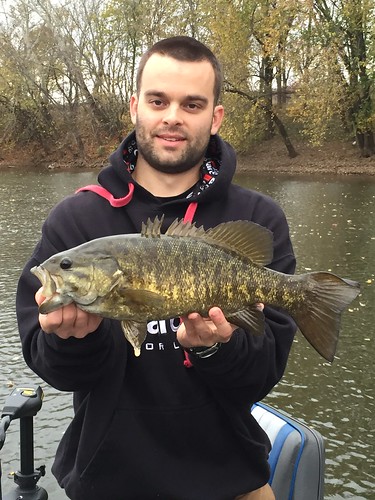By: Keith Lockwood
A couple of weeks ago while returning from an afternoon fishing trip in the lower Choptank, I happened to notice a boat that looked familiar off in the distance . Low and behold, as I got closer it turned out to be the Miss Kay, which is an oyster research vessel owned by the Fisheries Service. She and her crew were busy doing the annual fall oyster survey. The fall oyster survey has been conducted since 1939 by a succession of Maryland state agencies and for the last 26 years by the Maryland Department of Natural Resources. Annual Department of Natural Resources oyster surveys collect samples and data during 3 months at the same 260 fixed oyster habitat sites (oyster bars) in Maryland Chesapeake Bay waters. Oyster survey data helps the Department of Natural Resources efforts to manage, enhance, and conserve Maryland oyster populations, using annual survey data to measure and monitor trends for:
- Oyster abundance and biomass
- Oyster reproductive success and recruitment
- Natural oyster mortality
- Oyster health and diseases, including MSX, dermo, and others.
Copies (.pdf) of reports on results from annual Fall Surveys in historic context are available on our web site.

Photo by Keith Lockwood
My personal fall oyster survey results have been very good as far as I'm concerned. Like any Eastern Shore seafood lover I do love my oysters or "Auysters" as they are called here by locals. They've been full and fat, very few watery ones and due to salinities being in the high teens they sure do taste fine. Make sure to pick yourself up a ½ bushel or so and enjoy the smaller ones on the half shell. Take the larger oysters and roll them in rice flour, egg batter and panko crumbs and fry to your delight. Also feel free to use your own favorite recipe, especially if bacon is involved! They are also good on the grill; just place them on the grill (campfire preferred) and listen for a "pop" as they open and you're ready to go.
Water temperatures in the upper bay have dipped below the 50° mark this week and the bay and tidal river fisheries are showing obvious changes. Striped bass are still active in the upper bay but most of the action is occurring in about 35' of water along channel edges in the main stem of the bay. There are still small striped bass chasing bait but many are now being found suspended in waters up to 60' deep. Most boats are trolling a mixed spread of umbrella rigs, tandem bucktails or swim shads or spoons down deep along the channel edges. Jigging is still a good option when suspended fish can be located along channel breaks or structure such as the Bay Bridge rock piles and bridge piers. Striped bass of various sizes and white perch are now holding deep near the rock piles and deepest bridge piers and soon water temperatures will be cold enough that they will not be too interested in feeding.
The tidal rivers are running cooler than the main bay and striped bass are becoming less common in the rivers. White perch are being found in deep water at the mouths of the tidal rivers often in 50' or more of water. Jigging or fishing with bottom rigs and pieces of bloodworms has been effective when perch can be found on depth finders. Channel catfish are active in the tidal rivers as are flathead catfish near the Conowingo Dam. Yellow perch are active and can be caught on a variety small jigs or minnows along the lower sections of the region's tidal rivers, creeks and bay shores. John Hogan found some excellent yellow perch fishing recently on Gray's Run (a tributary to the Bush River).

Photo Courtesy of John Hogan
In the middle bay region striped bass are being found in about 35' to 40' along the shipping channel edges and channels leading into the major tidal rivers. Trolling has been a popular way to fish along these edges and most of the success is coming from the lures trolled at deeper depths. Umbrella rigs and tandem bucktails or Storm type lures are being pulled behind inline weights. Braided line is a valuable asset with this type of fishing since it has less water resistance than mono and allows for less weight to get lures down to the proper depths. The western shore side of the shipping channel from Breezy Point south has been offering some of the best trolling action. Ben Schrecongost is all smiles with this nice striped bass he caught and released while trolling off of Tilghman Island.

Photo Courtesy of Ben Schrecongost
There is still a lot of light tackle jigging action to be found in the middle bay region in the mouth of Eastern Bay, the mouth of the Choptank, the Severn and West River to name a few. At times diving sea gulls will lead the way when bait is being pushed to the surface by striped bass, other times a slick and or resting sea gulls can give clues to fish and bait suspended close to the bottom. Metal and soft plastic jigs work well and most often the better grade of striped bass are closer to the bottom and the surface action will most likely be smaller fish.
White perch can be found at times holding in deep water near the mouths of the region's major tidal rivers and jigging with a smaller sized but heavy metal jig combined with a dropper fly is a great way to fish for them as is a bottom rig baited with pieces of bloodworm. A good depth finder is very helpful in locating schools of white perch holding on deepwater reefs. Gizzard shad are sharing the same notion to find deeper water to spend the winter so if you spot a mass of fish on your depth finder at the mouth of a tidal river and find yourself scratching you head as to why they won't bite, they just might be a school of gizzard shad.
During the month of October anglers in the lower bay region tended to be somewhat jealous of the excellent striped bass fishing in the middle bay region and lamented about the lack of striped bass in the lower bay region. That all changed a couple of weeks ago and the fishing for striped bass now in the lower bay is some of the best to be seen anywhere in Maryland waters. There are still small striped bass in many areas but there is a large amount of larger striped bass from 20" to 30" to be found throughout the region. Most of the larger striped bass are deep and jigging and trolling have been the most popular ways to fish for them.
The eastern side of the bay is reported to have these larger striped bass spread from Hooper's Island south to Buoy 72 and down to the Middle Grounds. Jigging has been a fun way to catch them when concentrations of fish can be found. Often they will be located by diving sea gulls and breaking fish; either on top or underneath smaller fish that are causing all the fuss on the surface. There are still some sea trout around also which can be caught while jigging. This same kind of action can also be found on the western side of the bay and the lower Potomac River.
Trolling has been a good option for many and the most common way charter boats are fishing. Most are pulling umbrellas and tandem rigged bucktails behind inline weights to get down deep to where the fish are. The most common place the larger striped bass are being found is along channel edges in about 35' to 40' deep. It also pays to have a couple of larger bucktails out in a trolling spread since a few large fall migrant striped bass in the 50" size range have been caught recently. Tim Campbell holds up a nice striped bass he caught while trolling near Point Lookout.

Photo Courtesy of Tim Campbell
There are plenty of white perch to be found in the lower Patuxent River and other tidal rivers such as the Nanticoke. The perch are holding deep on oyster bars often in 50' of water. Jigging with a small but heavy metal jig and a dropper fly or a sinker and two dropper flies is the best way to put them in the boat. They freeze well and will last several months in the freezer. There are also plenty of eating size blue catfish in the tidal Potomac also and make a healthy addition to anyone's freezer.
Freshwater fishing in the western region of Maryland continues to be good for trout in most of the trout management waters. There are still plenty of trout in the put and take areas but they tend to be spread out. Anglers can up the odds by covering a lot of water by using lures such as spinners, small spoons or flies such as wooly buggers and streamers. The catch and release management waters offer excellent opportunities to enjoy the thrill of catching a nice trout and returning it back to the water for another angler to enjoy.
Deep Creek Lake has been offering some good fishing opportunities in various cove areas near existing grass in deeper waters. A mix of largemouth bass, smallmouth bass, northern pike, chain pickerel and large yellow perch can be found there. Tubes, spinnerbaits, crankbaits and jerkbaits have been some of the more popular lures to use. Walleye are being caught close to dark on some of the rocky and steep shoreline areas on jerkbaits.
The upper Potomac River is expected to rise in the next couple of days due to rain impact in the upper watershed. Anglers are urged to check water conditions before venturing out on the river. When conditions are favorable, fishing for smallmouth bass and walleye should be good. There has been some good walleye fishing in the lower Susquehanna River below the Conowingo Dam and there are also some large smallmouth bass being caught. Richard Norris holds up a beautiful upper Potomac smallmouth bass he caught on a tube and then released.

Photo Courtesy of Richard Norris
Fishing for largemouth bass in the freshwater impoundments and tidal waters of Maryland continues to be good this week. The largemouth bass are very active and tend to be holding in transition areas between the shallower areas and deeper waters. They are still on station and are positioned to intercept small baitfish and crayfish moving from the shallower areas where grass cover has diminished to deeper cover. Tubes, crankbaits and slow rolled spinnerbaits are all good lures to use in these areas. Targeting sunken wood and rocks in the deeper waters is also a good option and a variety of tubes, small crankbaits and grubs are good choices to working this cover.
Ocean City area anglers have been trying to be as patient as possible as they wait for the main body of the fall migration of large striped bass to arrive in Maryland waters. At present they seem to be hung up at Cape May, New Jersey. Large bluefish have arrived in our area and there are a lot still north of us that are on their way. Water temperatures at the Ocean City Inlet are around 54° today. This coming weekend could be the time for a bluefish blitz and good fishing for large striped bass. Surf casters will be using a variety of lures or bottom rigs baited with fresh menhaden bait. Out on the shoal areas boats will be trolling a mixed spread of Stretch 25's, umbrella rigs and large bucktails. There will also be plenty of folks live lining eels and jigging when fish can be spotted on depth finders.
Tautog season is now closed until January 1st but sea bass is still open and if you can get out on a party boat there is some excellent fishing opportunities. Limit catches are the norm and some of the sea bass being caught are of impressive size. Large flounder also continue to be part of the mix being caught at the wreck and reef sites. Farther offshore a few boats have been traveling out to the Baltimore Canyon where they have been catching yellowfin tuna and dolphin.
Boom...Morgan
No comments:
Post a Comment